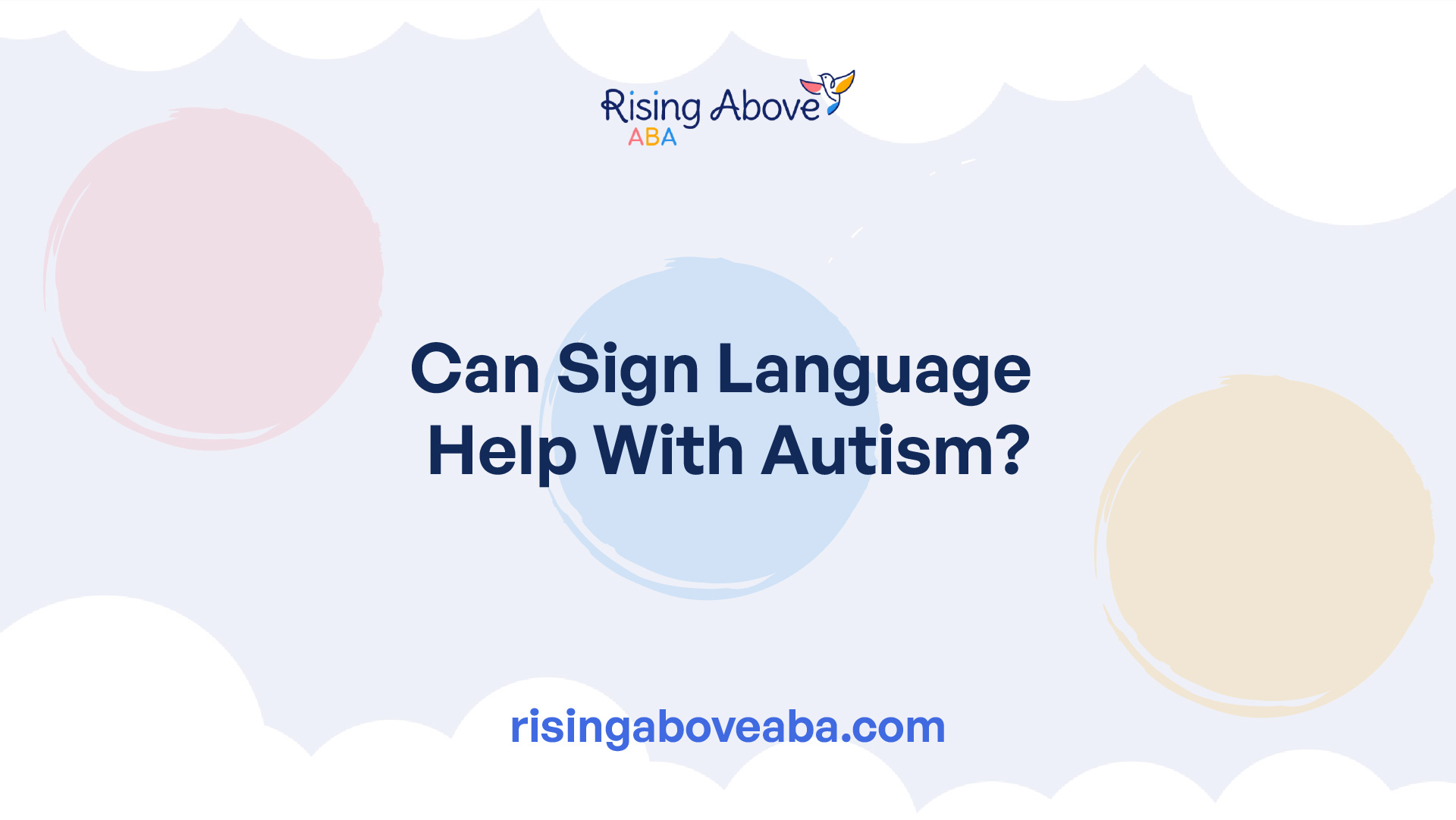Can Sign Language Help With Autism?
Unlocking the potential of sign language for autism: Explore the benefits and impact on communication and social interaction. Can sign language help with autism?

Sign Language and Autism
Sign language has shown promise in helping individuals with autism spectrum disorder (ASD) improve communication and social interaction skills. Sign language development in individuals with ASD can vary, but research has highlighted its potential benefits.
Sign Language Development in ASD
Studies have found that both deaf children with ASD and hearing children with ASD may exhibit echoing of signs or words during early linguistic development when comprehension is relatively low. This echoing behavior is similar to how hearing children with ASD echo words. However, it is important to note that completely nonverbal children with ASD may not gain spoken words through simultaneous communication.
Research suggests that nearly all autistic children can learn receptive and expressive signs, with many being able to combine signs. This learning process has demonstrated significant improvement in adaptive behaviors among these children. While speech skills are acquired by fewer autistic children, simultaneous speech and sign training have shown potential to help develop these skills [3].
Implementing sign language in therapy for individuals with ASD can provide various benefits, including enhanced communication, improved social interaction, and cognitive development. Sign language can serve as a bridge for individuals with ASD to express their needs, thoughts, and emotions, facilitating better communication with others. The visual nature of sign language can also support social interactions by providing additional cues for understanding and conveying meaning.
By utilizing sign language alongside other communication strategies, therapists can tailor interventions to meet the specific needs of individuals with ASD. This may involve the use of speech generating devices (SGDs) and teaching strategies that combine sign language and spoken language to encourage language development.
Further research is recommended to explore the effectiveness of sign language in improving communication outcomes for individuals with ASD. Areas for future investigation include exposure to fluent signers, training in discourse and code-switching, and evaluating different teaching methods with increased involvement from staff and parents. These efforts may contribute to a better understanding of how sign language can be effectively utilized to support individuals with ASD and enhance their overall development.

Types of Sign Language
When it comes to sign language, there are different systems used around the world. In the context of autism, two prominent types of sign language are American Sign Language (ASL) and Signed Exact English (SEE).
American Sign Language (ASL)
American Sign Language (ASL) is the standard sign language used in the United States and Canada. It has its own grammar, vocabulary, and syntax that doesn't always align with verbal English. As of 2019, approximately 1 million people in the United States were using ASL as their primary means of communication. Learning ASL can open doors for children with autism, facilitating communication with a wide community of ASL users.
ASL is a visually-based language, relying on handshapes, facial expressions, and body movements to convey meaning. It is a complete and expressive language with its own linguistic rules and cultural nuances. By learning ASL, individuals with autism can effectively communicate their thoughts, feelings, and needs to others.
Signed Exact English (SEE)
Signed Exact English (SEE) is another type of sign language that is used in conjunction with spoken or written English. SEE aims to represent English grammar and syntax more precisely through sign language. It incorporates signs for individual words, as well as grammatical markers and tenses.
SEE is often used in educational settings to support language development and literacy skills. It can be helpful for individuals with autism who struggle with verbal communication, as it provides a visual representation of the English language. SEE can aid in building vocabulary, understanding sentence structure, and improving overall language comprehension.
It's important to note that while ASL and SEE are two common sign languages used in the context of autism, there are other sign languages around the world that may be used in different regions. The choice of sign language depends on factors such as location, accessibility, and personal preference.
Understanding the different types of sign language allows individuals with autism and their families to explore communication options that best suit their needs. Whether it is ASL, SEE, or another sign language, the visual nature of sign language can provide a valuable means of expression and connection for individuals with autism.
Benefits of Sign Language for Autism
Sign language has proven to be a powerful tool in the realm of autism, offering numerous benefits for individuals on the spectrum. It provides an alternative mode of communication that bypasses verbal challenges and facilitates expression, empowering individuals with autism to communicate their thoughts, needs, and emotions more effectively. Let's explore some of the key benefits of sign language for individuals with autism.
Communication Enhancement
One of the primary benefits of sign language for individuals with autism is the enhancement of communication skills. Sign language offers a visual and kinesthetic means of communication, allowing individuals with autism to express themselves more clearly and effectively. By using signs and gestures, they can overcome the challenges associated with verbal communication and establish a more meaningful connection with others.
Additionally, sign language can help improve receptive language skills, enabling individuals with autism to better understand and comprehend spoken language. This enhanced communication ability can lead to increased independence, improved social interactions, and a greater sense of self-confidence.
Social Interaction Support
Sign language also plays a vital role in supporting social interaction for individuals with autism. It provides a structured and visual means of communication, making it easier for them to initiate and engage in conversations with others. By using sign language, individuals with autism can effectively express their thoughts, needs, and emotions, fostering better understanding and empathy from their peers and caregivers.
Moreover, sign language encourages turn-taking and reciprocity during conversations, promoting the development of valuable social skills. It can help individuals with autism establish connections and build relationships, leading to improved social interactions and a greater sense of belonging.
Cognitive Development
Sign language has a positive impact on the cognitive development of individuals with autism. By engaging in sign language, they can enhance their language and vocabulary skills, memory, learning abilities, and academic performance. The visual and kinesthetic nature of sign language helps individuals with autism better understand and retain information, improving their cognitive processing and comprehension skills.
Research suggests that incorporating sign language into educational settings can support learning and retention of academic concepts. It provides a multisensory approach to learning, which can be particularly beneficial for individuals with autism who may have different learning styles and preferences.
The benefits of sign language for individuals with autism extend beyond communication enhancement. It also promotes emotional expression and regulation by reducing frustration and anxiety, empowering individuals with autism to better understand and manage their emotions. By embracing sign language as a tool for communication, individuals with autism can experience improved social interactions, enhanced cognitive skills, and greater emotional well-being.
Sign Language vs. Verbal Communication
When considering the use of sign language as a communication tool for individuals with autism, it's important to understand the differences between sign language and verbal communication, as well as the potential impact on speech development.
Language Differences
Sign language and verbal communication are distinct forms of language with their own unique characteristics. Sign language, such as American Sign Language (ASL) and Signed Exact English (SEE), relies on visual-gestural communication, utilizing handshapes, facial expressions, and body movements to convey meaning. On the other hand, verbal communication involves the use of spoken words and vocalizations to express thoughts and ideas.
For individuals with autism, sign language can offer an alternative means of communication that bypasses the challenges often associated with verbal language. Some individuals with autism may experience difficulties with expressive and receptive language skills, making it challenging for them to effectively communicate their needs, thoughts, and emotions. Sign language provides a visual and kinesthetic mode of communication that can enhance understanding and expression, allowing individuals with autism to effectively relay their messages.
Impact on Speech Development
The impact of sign language on speech development in individuals with autism has been a topic of research and debate. Studies have shown that a combination of sign language and ongoing speech therapy, known as "simultaneous communication," can stimulate language development in children with autism. However, it is important to note that completely nonverbal children may not gain spoken words through simultaneous communication.
Research suggests that speech skills are acquired by fewer autistic children, and simultaneous speech and sign training may help in developing these skills. However, it is worth noting that some studies have found differences in speech outcomes between children exposed to sign language and those without sign language exposure. Children without sign language exposure tend to produce more intelligible speech compared to those exposed to sign language.
Moreover, children without early sign language exposure have shown better speech recognition skills and achieved age-appropriate spoken language compared to those exposed to sign language. Over time, children without sign language exposure have exhibited a statistically significant advantage in spoken language and reading skills.
While sign language can support communication and language development for individuals with autism, it is essential to consider individual needs and preferences. Some individuals may benefit from a combination of sign language and verbal communication, while others may thrive with solely verbal communication. The decision should be made in consultation with professionals and based on the unique needs and abilities of each individual with autism.
Implementing Sign Language in Therapy
When it comes to using sign language as a tool in therapy for individuals with autism, there are various methods and devices available. Implementing sign language can greatly enhance communication and interaction skills for individuals with autism spectrum disorder (ASD). Two effective approaches for incorporating sign language in therapy are the use of Speech Generating Devices (SGDs) and specific teaching strategies.
Speech Generating Devices (SGDs)
Speech Generating Devices (SGDs) have proven to be effective tools, particularly for children and young adults with ASD, in aiding communication. SGDs provide individuals with a visual and auditory representation of vocabulary words, allowing them to combine words to form meaningful sentences. This technology helps children develop language and verbal speech faster, as it provides them with a structured and visual method to communicate [9].
Teaching Strategies
In addition to SGDs, specific teaching strategies can be employed to facilitate the integration of sign language in therapy for individuals with autism. These strategies aim to enhance communication skills and promote language development. Some effective teaching strategies include:
- Visual Supports: Utilizing visual supports, such as sign language charts, flashcards, or visual schedules, can aid in reinforcing communication skills and supporting language comprehension.
- Repetition and Modeling: Consistent repetition and modeling of signs help individuals with autism understand and imitate the signs more effectively. Therapists can use repetition and modeling techniques to introduce new signs and reinforce previously learned ones.
- Multisensory Approach: Incorporating a multisensory approach by combining visual, auditory, and tactile cues can enhance learning and retention of sign language. This approach can involve using gestures, facial expressions, and physical prompts along with verbal and visual cues.
- Individualized Instruction: Tailoring the teaching methods and pace of sign language instruction to each individual's needs and abilities can optimize the learning experience. Recognizing and building on an individual's strengths can promote engagement and progress.
It is important for therapists and educators to carefully consider the potential benefits and drawbacks of using sign language as an assistive technology or communication method for individuals with ASD. Ongoing assessment and evaluation are crucial to identify the most effective strategies and devices for each individual, taking into account their unique communication needs and goals.
Further research is recommended to explore various teaching methods, including exposure to fluent signers, training in discourse and code-switching, and increased involvement of staff and parents in sign language instruction [3]. Data from studies involving over 100 children with autism have shown positive outcomes in terms of improved communication and adaptive skills when sign language is taught to nonspeaking autistic children.
By implementing sign language in therapy using SGDs and effective teaching strategies, individuals with autism can enhance their communication skills and make meaningful strides towards improved language development. Therapists and educators play a vital role in utilizing these tools and strategies to create a supportive and inclusive environment for individuals with ASD to thrive.
Research Findings and Recommendations
When it comes to the effectiveness of sign language in helping individuals with autism, research has provided valuable insights into the benefits it can offer. Sign language has proven to be a powerful tool in the realm of autism, offering numerous advantages for individuals on the spectrum.
Effectiveness of Sign Language
Research has shown that sign language may help children with autism develop speech, but even if speech development is not achieved, sign language remains a valid and useful tool for connecting with the people around them [5]. Sign language provides an alternative mode of communication that bypasses verbal challenges and facilitates expression for individuals with autism, empowering them to convey their thoughts, needs, and emotions more effectively [6].
The benefits of sign language for individuals with autism extend beyond communication enhancement. Sign language has been found to facilitate social interaction, supporting individuals in developing social skills and fostering connections with others. It also plays a significant role in supporting cognitive development by enhancing language and vocabulary skills, memory, learning abilities, and academic performance. Additionally, sign language serves as a powerful tool for emotional expression and regulation, reducing frustration and anxiety, promoting self-regulation, and improving emotional well-being in individuals with autism.
Future Research Suggestions
To further explore the potential of sign language in supporting individuals with autism, future research should focus on various aspects. It is recommended that studies investigate the benefits of exposure to fluent signers, as well as training in discourse and code-switching. Exploring different sign language teaching methods with increased involvement from staff and parents could also provide valuable insights [3].
Furthermore, future research should aim to conduct sign language training within the children's total environment to enhance learning outcomes. This holistic approach would allow for a comprehensive understanding of how sign language can be integrated into various settings to maximize its effectiveness. Existing data on over 100 children with autism already supports the effectiveness of teaching sign language to nonspeaking autistic children, leading to improved communication and adaptive skills.
By continuing to explore the effectiveness of sign language and its potential applications in different contexts, researchers can contribute to the development of more comprehensive strategies for supporting individuals with autism in their communication and overall well-being.
References

Compassion. Communication. Positivity. Professionalism
Give us a call at 888.572.7473 or reach out to our team online to get started—we're looking forward to partnering with your family.
Latest articles






Reach Out to Rising Above ABA

Most commercial insurance accepted
Contact us for any questions regarding coverage or plans – we’ll be happy to provide you with the clear guidance as to your best options.


